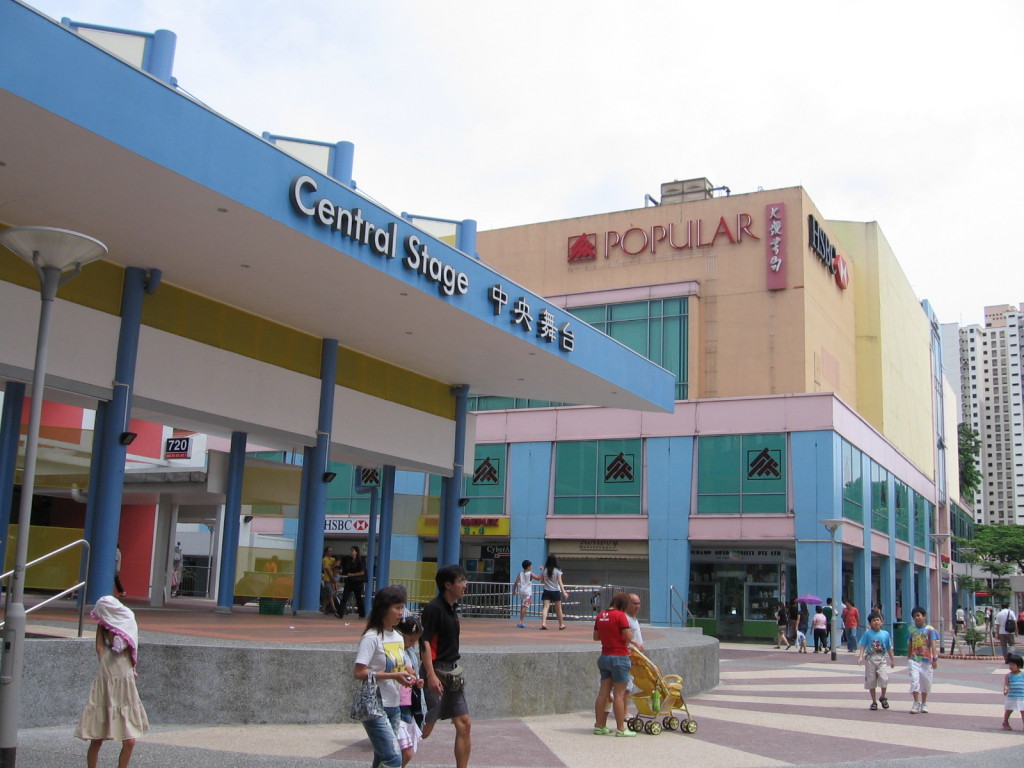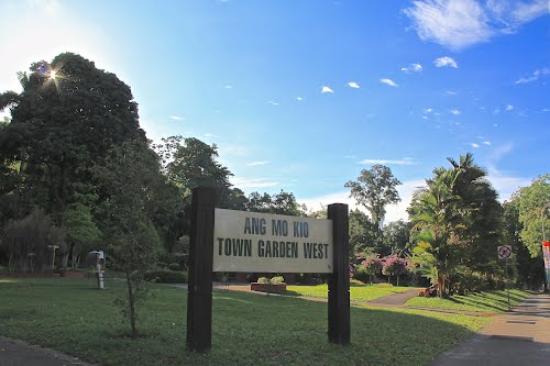Singapore /Singapore /Singapore
Sight Address : Ang Mo Kio Town,Singapore, Singapore.Edit
Detail InformationEdit
Ang Mo Kio(宏茂桥) is a heartland new town located in north central Singapore, and is generally within the North-East Region. It contains many of the common features of the island nation’s neighbourhoods, e.g. hawker centres, wet markets and HDB housing blocks. Singapore’s Prime Minister, Lee Hsien Loong is the Member of Parliament for this constituency. As an urban planning division, the Ang Mo Kio Planning Area lies within this region.The actual source of the name comes from the old survey maps which label the land as “Mukim of Ang Mo Kio” (Mukim meaning “area” or “precinct” in Malay). The word “Ang Mo” 红毛 may in fact not refer to Westerners. Rather, it is derived from two separate combined phrases in Hokkien. Ang Mo Dan means “rambutan” 红毛丹, a local fruit, red and covered in hair, found plentifully around the areas of old kampongs. Likely the second suffix “kio” 桥 (“bridge” or “bridges” in Hokkien) was added to the prefix “Ang Mo” 红毛 as an additional description to indicate a more precise location that residents would recognize i.e.红毛桥. There were many concrete bridges built by the old kampong dwellers. It first appears on the early maps drawn by surveyors who took those two phrases and combined them to form “Mukim of Ang Mo Kio” (“District of Ang Mo Kio”). The actual location of Ang Mo Kio New Town has been also known by the former name Kou-teu kio, Hokkien for “Ninth Bridge”.
HistoryEdit
Ang Mo Kio New Town is in a dynamically changing environment. Further improvements made to the town are still in process under the HDB and the Town Councils established in the various housing estates on the island. It has the overall preview of the Ministry of National Development. The administrators have successfully completed various phases. For example, they have upgraded programs in their strategic planning of the overall Island City of Singapore.The area remained largely uninhabited throughout the 19th century. Settlers, were attracted to the area only around the start of the 20th century, as a result of the rubber boom. In the old maps of Singapore, much of the area was labelled as the Ang Mo Kio Forest Reserve with many plantation estates.The village that sprang up with the clearing of the land took on the name “Ang Mo Kio”. The immigrant Chinese, mostly Hokkiens were engaged in rubber-planting and tapping. Cheng San Village where Ang Mo Kio New Town now stands was once a huge rubber plantation. The 1922 to 1932 world slump in rubber prices made many tappers and labourers turn to pig and poultry farming or market gardening. During World War II when Singapore was occupied, more people moved to Ang Mo Kio to take up farming.Development of Ang Mo Kio New Town began in 1973, and was the seventh New Town to be built in Singapore. The early stage of construction took place by the Housing and Development Board under the Ministry of National Development, completed in 1980. The present 29 hectares (72 acres) self-contained town centre was built over an elongated valley formerly occupied by squatters. It has commercial offices, cultural and community facilities serving at least 200,000 residents.The design of the town won the Singapore Institute of Architects (SIA) Outstanding Buildings Award in 1983. The swimming complex at Avenue 1 also won the 1986 SIA Architectural Award for its unique “tetrahedral skylight” design. The first town to be designed in metric dimensions, it was the seventh housing estate town developed by the Housing and Development Board (HDB).After more than thirty years of existence, it is considered one of the matured housing estates with established markets, schools, institutions, community, residential, administrative centers, and even a community hospital and other important amenities for the housing residents.
Must SeeEdit
Must see
Visiting TimeEdit
10.00 am – 9.00 pm
Closed OnEdit
N.A.
Best Season to VisitEdit
June to July and November to December.
Best Time To VisitEdit
Evening
Time Required for SightseeingEdit
N.A.
Ticket Required : No Edit
Individual National Adult : N.A.
Kids : N.A.
Individual Foreigner Adult : N.A.
Kids : N.A.
Still Photo Camera : N.A.
Video Camera : N.A.
Guide Required : No Edit
Approximate cost: N.A.
Dress Code (If Any) : No Edit
Dress Require: N.A.
Restaurants NearbyAdd / Edit
- New York New York ; 53 Ang Mo Kio Avenue 3 Singapore 569933 ; Ph/M – 65 6853 3907 ; Food Serve – American Restaurant.
How to ReachEdit
Taxi : Taxis are generally very hard to get during peak hours (Mon-Fri 7:00am – 9:30am and Mon-Sat 5:00pm – 8:00pm) and on rainy days. If you are at a hotel, have conceirge call you a taxi. If you are out about town and have access to a cell phone- calling for a taxi will cut your wait time by 20 to 30 minutes. All taxis are fitted with meters; all are air conditioned; the majority of the taxis are 5-seaters; about 90% of taxis have radiophones; call booking is done via GPS or digital voice dispatch. All passengers must fasten their seat belts by law.
For taxi Booking fee is SGD $2.3. Minimum fare for taxi is SGD $3 for first 1Km. Fare above minimum fare until 10Km is SGD $0.55 per Km. Fare above 10Km is charge SGD $0.628 per Km. Taxi Waiting charges per hour is SGD $17.6. Peak Hours charges is diffrent.
BUS : Public buses run daily from 5.30am to midnight. Extended night services cost slightly more (a flat rate ranging from $1.50-$3.00). Otherwise, most fares depend on distance travelled and range from 67 cents to $1.58 for air-conditioned comfort (almost all public buses in Singapore have air-conditioning today). There are also “feeder” bus services that charge a flat rate of 67 cents. Each bus should not take more than 15 to 20 minutes to arrive at the bus stop.
Train : Singapore MRT system is very well connected to different parts of Singapore and very clean! If you have the time and plan to explore around little Sunny island, get the the Singapore Tourist Pass!
It runs 6am-12mn, fares start at S$1 (70cents in EZ link). Tickets can be purchased in all MRT stations. You just have to insert your money through the ticket machine. Rush hour’s usually 7am-9am, 11am-2pm and 4pm-7pm.
Air : Changi Airport is the country’s main airport. From the airport there are a number of ways to get into the city:
Taxi is easiest – simply follow the signs after clearing customs. Meters are always used in Singapore and prices are reasonable. A trip to the city during the day will be between $20-$30 including $3-5 airport surcharge. An additional 50% surcharge applies between midnight and 06:00.
Limousines charge a flat $50 to anywhere in the city and are a pretty good deal after midnight, as you can skip the queue and avoid the surcharge. The same pricing applies to chartering van-sized MaxiCabs, which are good for large families or if you have lots of baggage.
Shuttle – Shared six-seater MaxiCab shuttle service to designated areas/hotels costs $7 and can be booked in advance or in the arrivals hall. 6AM-2AM, every 15-30 min.
Subway – MRT trains run from a station between T2 and T3, but you’ll need to change trains at Tanah Merah to a city-bound train: just exit through the left hand side door and cross the platform. The 30 min ride to City Hall station costs $1.90 plus a refundable $1 deposit, and trains run 05:31-23:18.
Bus – Bus terminals can be found in the basements of T1, T2 and T3. 06:00-23:59 only. Fares are less than $2.00, exact fare required (no change given) if you pay cash.
Others : N.A.
Things to CarryEdit
- Carry drinking of Bottled water
Safety / WarningEdit
- Please be advised that all bags and personal items are subject to inspection.
HelplineEdit
- Police: 999
- Emergencies/Ambulance/Fire Brigade: 999
- Police Hotline: 1800 353 0000
- Non-emergency ambulance: 1777
- Flight Information (24-hours): 1800-542 4422
- Tourism Information (24-hours): 1800-736 2000







